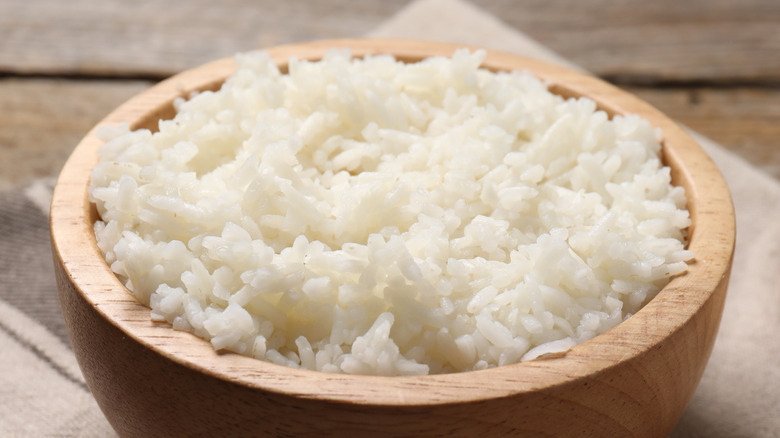Vinegar Can Solve One Of Your Most Annoying Rice Problems
With the exception of short grain varieties like arborio, glutinous, and bomba rice used in paella, most types of rice strive for fluffy, separated grains when cooked. Unfortunately, one of the most common and annoying rice problems faced in countless kitchens is gummy, sticky, or soggy rice. Luckily, vinegar is a household staple that can solve these rice problems before they start.
The culprit behind the gummy consistency we dread in a pot of poorly prepared rice is starch. Starch helps rice absorb water so it can cook, but it also gelatinizes, causing the grains to stick together for subpar texture. Vinegar prevents gelatinization because it releases hydrogen ions that react with starch molecules to inhibit them from binding together. By separating the starch molecules, vinegar effectively separates the steamed grains of rice for a perfect fluffy texture.
So, as you add rice and water to your rice cooker or stove pot, stir in a dash of vinegar before bringing everything to a boil. A teaspoon of vinegar per cup of rice should be all you need to prevent clumping. You can use white vinegar, rice vinegar, or apple cider vinegar. As an added bonus, vinegar has also been shown to reduce the glycemic index of rice, making it easier to process for diabetics.
More tips for fluffy rice
Vinegar will be your secret weapon for cooking the best pot of long or medium grain rice. And there are other simple tips that work in conjunction with vinegar to further solidify successful results. The first is rinsing your rice in a sieve or colander under running water, or soaking it in water for a few minutes before draining it. This will rid rice of excess starch and also wash out any unwanted debris. If you're looking for a fine-holed colander that won't let any grains slip through the holes, this set of micro-perforated HÖLM ones will prove useful.
Another important step is to let the rice rest covered in the steaming pot for five to ten minutes after it's done. A resting period will finish steaming the rice, distributing moisture and ensuring an even texture throughout. Once you lift the top off, use a fork to fluff the rice. This will further separate the grains and prevent clumping when you serve it.
It isn't advisable to add vinegar retroactively. Ironically, adding vinegar to steaming, cooked rice might increase gelatinization as evidenced by sushi rice. If your rice is sticky or gummy, the best way to salvage it is to rinse it through a colander, spread it over a baking sheet, and dry it out in the oven for five minutes in a 350 degree Fahrenheit oven. Some also recommend steaming mushy rice for an extra 5-10 minutes with a piece of stale bread on top of the mound to absorb the extra moisture.

